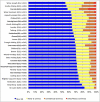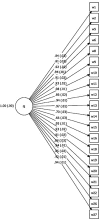A novel household water insecurity scale: Procedures and psychometric analysis among postpartum women in western Kenya
- PMID: 29883462
- PMCID: PMC5993289
- DOI: 10.1371/journal.pone.0198591
A novel household water insecurity scale: Procedures and psychometric analysis among postpartum women in western Kenya
Abstract
Our ability to measure household-level food insecurity has revealed its critical role in a range of physical, psychosocial, and health outcomes. Currently, there is no analogous, standardized instrument for quantifying household-level water insecurity, which prevents us from understanding both its prevalence and consequences. Therefore, our objectives were to develop and validate a household water insecurity scale appropriate for use in our cohort in western Kenya. We used a range of qualitative techniques to develop a preliminary set of 29 household water insecurity questions and administered those questions at 15 and 18 months postpartum, concurrent with a suite of other survey modules. These data were complemented by data on quantity of water used and stored, and microbiological quality. Inter-item and item-total correlations were performed to reduce scale items to 20. Exploratory factor and parallel analyses were used to determine the latent factor structure; a unidimensional scale was hypothesized and tested using confirmatory factor and bifactor analyses, along with multiple statistical fit indices. Reliability was assessed using Cronbach's alpha and the coefficient of stability, which produced a coefficient alpha of 0.97 at 15 and 18 months postpartum and a coefficient of stability of 0.62. Predictive, convergent and discriminant validity of the final household water insecurity scale were supported based on relationships with food insecurity, perceived stress, per capita household water use, and time and money spent acquiring water. The resultant scale is a valid and reliable instrument. It can be used in this setting to test a range of hypotheses about the role of household water insecurity in numerous physical and psychosocial health outcomes, to identify the households most vulnerable to water insecurity, and to evaluate the effects of water-related interventions. To extend its applicability, we encourage efforts to develop a cross-culturally valid scale using robust qualitative and quantitative techniques.
Conflict of interest statement
The authors have declared that no competing interests exist.
Figures




References
-
- Jepson W, Wutich A, Collins SM, Boateng GO, Young SL. Progress in household water insecurity metrics: a cross-disciplinary approach. WIRES Water. 2017; doi: 10.1002/wat2.1226 - DOI
-
- Stevenson EGJ, Greene LE, Maes KC, Ambelu A, Tesfaye YA, Rheingans R, et al. Water insecurity in 3 dimensions: An anthropological perspective on water and women’s psychosocial distress in Ethiopia. Soc Sci Med. 2012;75: 392–400. doi: 10.1016/j.socscimed.2012.03.022 - DOI - PMC - PubMed
-
- Tsai AC, Kakuhikire B, Mushavi R, Vořechovská D, Perkins JM, McDonough AQ, et al. Population-based study of intra-household gender differences in water insecurity: reliability and validity of a survey instrument for use in rural Uganda. J Water Health. 2016;14: 280–292. doi: 10.2166/wh.2015.165 - DOI - PMC - PubMed
-
- Wutich A, Ragsdale K. Water insecurity and emotional distress: Coping with supply, access, and seasonal variability of water in a Bolivian squatter settlement. Soc Sci Med. 2008;67: 2116–2125. doi: 10.1016/j.socscimed.2008.09.042 - DOI - PubMed
-
- Webb P, Iskandarani M. Water Insecurity and the Poor: Issues and Research Needs ZEF, Bonn, Germany: University of Bonn;1998.
Publication types
MeSH terms
Substances
Grants and funding
LinkOut - more resources
Full Text Sources
Other Literature Sources
Medical

